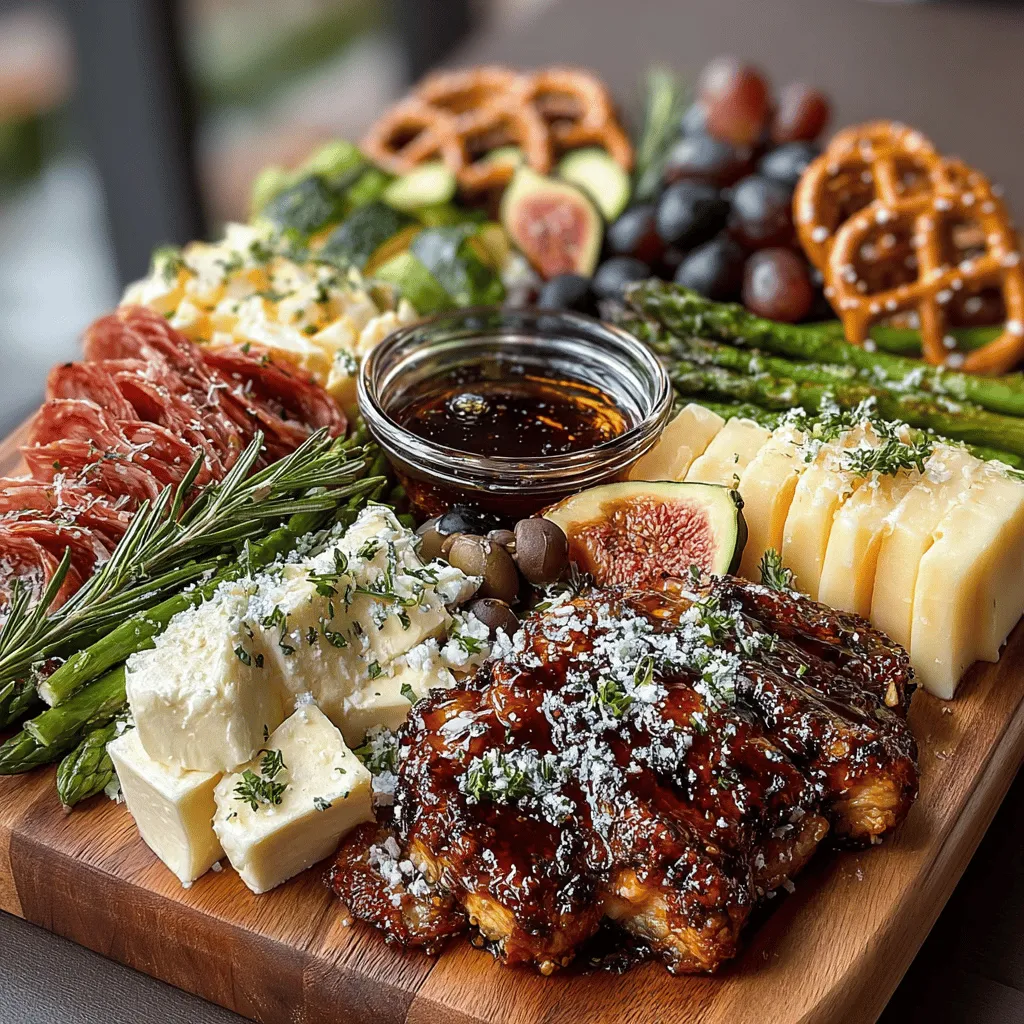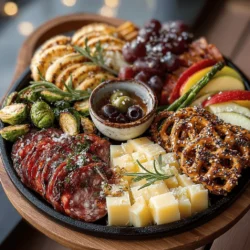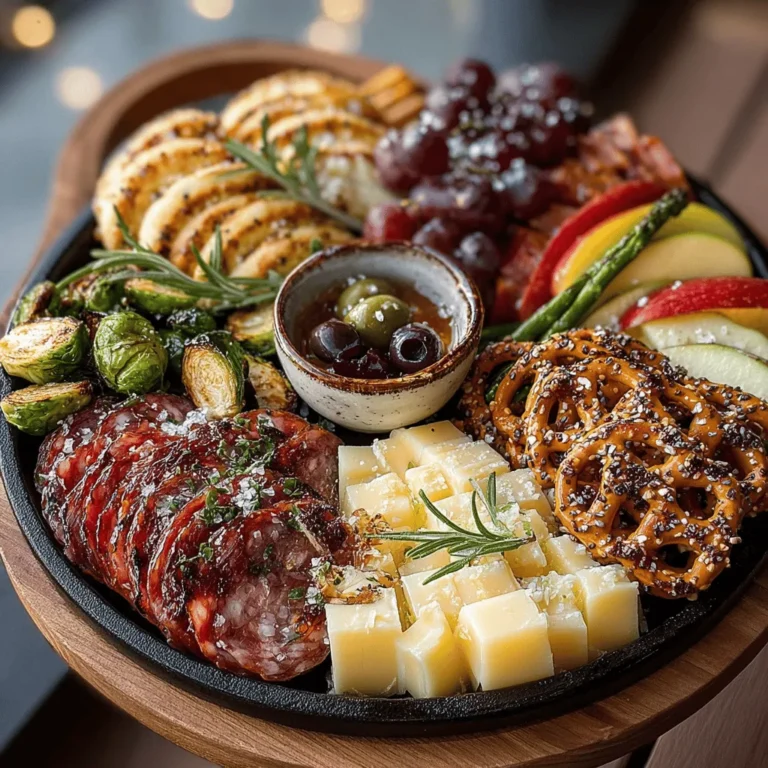Savory Baked Charcuterie Board: A Warm Twist on a Timeless Classic
Charcuterie boards have surged in popularity over the past few years, becoming a staple at gatherings, celebrations, and casual get-togethers. These artfully arranged platters of cured meats, cheeses, fruits, and accompaniments not only serve as a feast for the palate but also as a visual centerpiece that encourages sharing and conversation. The traditional charcuterie board has captivated food enthusiasts with its variety and appeal, and now a new trend is rising: the savory baked charcuterie board. This innovative twist takes the classic concept and warms it up, offering a cozy and inviting experience that is perfect for any occasion.
The baked charcuterie board combines the elements of a traditional board with the comforting allure of warm, melted cheeses and roasted meats. This delicious fusion creates a harmonious blend of savory and sweet flavors, making it an ideal centerpiece for gatherings, date nights, or even a cozy evening at home. The beauty of a baked charcuterie board lies in its versatility; you can mix and match ingredients to suit your taste or the season, ensuring that each creation is unique and exciting.
Understanding Charcuterie Boards
To appreciate the essence of a savory baked charcuterie board, it’s important to first understand what a charcuterie board is and its rich history. The term “charcuterie” originates from France, where it traditionally referred to the art of preparing and presenting cured meats. Over time, this culinary practice has evolved beyond just meats to include a wide variety of accompaniments such as cheeses, nuts, fruits, and spreads.
Historically, charcuterie boards were a way to preserve meats, showcasing the skills of artisans who crafted sausages, pâtés, and other cured products. In many cultures, the charcuterie platter holds a special place, reflecting local ingredients and culinary traditions. From the Spanish jamón ibérico to Italian antipasto, charcuterie has been celebrated across the globe, each region adding its flair and flavors.
The evolution of charcuterie boards has seen them transition from simple meat and cheese arrangements to elaborate displays that feature a wide array of tastes and textures. Today’s charcuterie boards can be customized for any occasion, whether it’s a fancy wedding reception or a casual movie night. The introduction of the baked charcuterie board brings a new dimension to this beloved tradition, allowing for an even greater range of flavors while maintaining the communal spirit that makes charcuterie so appealing.
Key Ingredients for the Perfect Savory Baked Charcuterie Board
Creating a savory baked charcuterie board is all about selecting the right ingredients that not only work well together but also elevate the overall experience. Here are the essential components to consider:
Assorted Cheeses
Cheese is the heart of any charcuterie board, and choosing the right varieties is crucial for achieving a balanced flavor profile. For a baked charcuterie board, consider using a combination of soft, semi-soft, and hard cheeses. Creamy brie, nutty gouda, and sharp aged cheddar are all excellent choices. Each type of cheese brings its own unique texture and flavor, creating a symphony of tastes when melted together.
Brie offers a rich, buttery flavor that becomes creamy and luxurious when baked. Gouda, with its slightly sweet and smoky notes, adds depth, while aged cheddar provides a sharp contrast that enhances the overall experience. When selecting cheeses, aim for a balance of textures—creamy, crumbly, and firm—to create a visually enticing and flavorful spread.
Cured Meats
No charcuterie board is complete without an assortment of cured meats. Salami, prosciutto, and chorizo are popular choices that not only add savory richness but also contribute to the board’s visual appeal. The key to arranging cured meats is to consider both taste and presentation. Layering different meats and folding them creatively can make for an eye-catching display.
Salami, with its robust flavors, pairs wonderfully with cheese, while the delicate, melt-in-your-mouth texture of prosciutto offers a contrasting experience. Chorizo, with its spicy and smoky notes, can add a kick to your baked board. When selecting cured meats, consider the flavor profiles and how they will complement the cheeses and other ingredients you’ve chosen.
Olives and Nuts
Incorporating olives and nuts into your baked charcuterie board adds both flavor and texture. Olives, whether green or black, contribute brininess that can cut through the richness of the cheeses and meats, providing a refreshing contrast. Choosing a mix of olives can also add visual interest, showcasing a variety of colors and shapes.
Nuts, such as almonds, walnuts, or pecans, bring a delightful crunch to the board. They not only enhance the overall texture but also add an additional layer of flavor. Roasting the nuts beforehand can intensify their natural oils and create a warm, inviting element that ties nicely with the baked components of the board.
Seasonal Fruits
To round off your savory baked charcuterie board, including a selection of seasonal fruits is essential. Fruits like figs, grapes, and apples not only add a pop of color but also introduce a natural sweetness that balances the savory elements. The juiciness of fresh fruits can provide a refreshing contrast to the richness of the cheeses and meats, making each bite a delightful experience.
Selecting seasonal fruits ensures that your board is not only delicious but also visually appealing. For instance, figs can add a luxurious touch with their unique shape and sweetness, while grapes offer a burst of juiciness. Apples, with their crisp texture and tart flavor, can add a refreshing crunch. When arranging fruits, consider their colors and shapes to create a visually stunning presentation.
Initial Steps to Prepare Your Savory Baked Charcuterie Board
Now that you have a grasp of the key ingredients, it’s time to delve into the initial steps for preparing your savory baked charcuterie board. Start by gathering all your chosen ingredients and preheating your oven, as some components may need a quick bake to enhance their flavors.
1. Choose Your Baking Dish: Select a large, oven-safe platter or baking sheet that will serve as the base for your charcuterie board. The size of the dish will largely depend on the number of guests you’ll be serving. Make sure it has enough space to accommodate all your ingredients without overcrowding.
2. Prepare the Ingredients: Slice and arrange your cheeses, cured meats, and any other components in a way that allows for easy serving. You may want to pre-bake certain items, such as nuts, to enhance their flavor. Simply toss them in a bit of olive oil and your favorite spices before roasting them in the oven for a few minutes.
3. Layer the Flavors: Begin by placing the cheeses on the board, spacing them out to create visual harmony. Follow with an arrangement of cured meats, ensuring to fold and layer them to add dimension. Next, fill in gaps with olives, nuts, and seasonal fruits, creating a colorful and inviting display.
4. Bake to Perfection: Once your board is arranged, it’s time to bake. Pop your charcuterie board into the preheated oven, allowing the cheeses to melt slightly and the meats to warm up. This will take only a few minutes, so keep a close eye to ensure nothing overcooks.
By following these initial steps, you’ll set the stage for a delightful savory baked charcuterie board that promises to impress your guests and elevate your gatherings. As you prepare to serve, take a moment to appreciate the colorful array of ingredients and the tantalizing aromas that will soon fill the room.

Creating a savory baked charcuterie board is not just about food; it’s an experience that combines flavors, textures, and aesthetics. This guide will take you through the essential elements that make your charcuterie board not only delicious but also visually appealing. We’ll explore the importance of roasted vegetables, crunchy elements like pretzels or crackers, the sweetness of honey or fig spread, and the freshness of herbs that elevate your board.
Roasted Vegetables
Selecting Seasonal Vegetables
For a baked charcuterie board, seasonal vegetables add a burst of flavor and color. Consider including:
– Zucchini: This versatile vegetable can be sliced, cubed, or even spiraled. When roasted, it becomes tender and slightly sweet, complementing the savory elements of your board.
– Bell Peppers: Choose a mix of colors—red, yellow, and green—for a vibrant look. Roasting bell peppers enhances their natural sweetness and adds a smoky depth.
– Asparagus: This elegant vegetable brings a delightful crunch. Roasted asparagus has a unique flavor that pairs well with cheeses and cured meats.
Techniques for Roasting to Bring Out Flavors
To roast your vegetables:
1. Preheat the Oven: Set your oven to 425°F (220°C). A high temperature allows for caramelization, which intensifies the flavors.
2. Prepare the Vegetables: Wash and cut your vegetables into uniform pieces for even cooking. Toss them in a bowl with olive oil, salt, and pepper. For extra flavor, consider adding garlic powder or herbs.
3. Roast: Spread the vegetables in a single layer on a baking sheet lined with parchment paper. Roast for about 20-25 minutes, or until they are golden brown and tender, stirring halfway through to ensure even cooking.
4. Cool Before Serving: Once roasted, let the vegetables cool slightly before adding them to your charcuterie board. This prevents them from wilting other ingredients.
Pretzels or Crackers
The Purpose of Including Crunchy Elements for Texture
Incorporating crunchy elements like pretzels or crackers into your charcuterie board is essential for balancing the softer textures of cheeses and roasted vegetables. The crunch not only adds a delightful contrast in texture but also serves as a vessel for various toppings.
Recommendations for Pairing with Cheeses and Meats
– Pretzels: Soft pretzels can be served warm, while hard pretzels provide a satisfying crunch. Pair them with creamy cheeses like Brie or sharp cheddar for a perfect bite.
– Crackers: Choose a variety of crackers, such as water crackers, sesame crisps, or whole grain varieties. These can enhance the flavors of meats like salami or prosciutto. Consider including gluten-free options for those with dietary restrictions.
Honey or Fig Spread
The Sweet Element’s Role in Balancing Savory Flavors
Adding a sweet element such as honey or fig spread is crucial for achieving a well-rounded flavor profile. The sweetness cuts through the richness of cheeses and meats, creating a delightful contrast that tantalizes the palate.
Tips for Warming and Drizzling for Enhanced Flavor
– Honey: Warm honey slightly in the microwave to make it easier to drizzle. A light drizzle over cheese or roasted vegetables can enhance their flavors significantly.
– Fig Spread: Serve fig spread at room temperature for optimal flavor. It pairs beautifully with blue cheese or goat cheese, adding both sweetness and depth.
Fresh Herbs for Garnish
The Aesthetic and Aromatic Benefits of Herbs
Fresh herbs add not only a pop of color to your charcuterie board but also a burst of aroma. Herbs like rosemary and thyme can elevate the presentation, making your board look more inviting.
Tips for Using Fresh Herbs
– Garnishing: Scatter fresh rosemary or thyme sprigs around your board or tuck them between the other ingredients. This adds a rustic charm and enhances the overall sensory experience.
– Herb Infusions: Consider infusing olive oil with herbs to drizzle over your vegetables or meats for an additional layer of flavor.
Step-by-Step Instructions for Creating Your Baked Charcuterie Board
1. Gather Your Ingredients: Assemble all your ingredients, including cheeses, meats, roasted vegetables, pretzels or crackers, honey or fig spread, and fresh herbs.
2. Choose Your Board: Select a large wooden board, slate, or a platter that provides ample space for arrangement. Ensure it’s clean and dry before use.
3. Start with the Base: Begin by placing your cheeses on the board. Space them out to create visual interest.
4. Add the Meats: Arrange cured meats around the cheeses. You can fold or roll slices for a more appealing presentation.
5. Incorporate Roasted Vegetables: Place the roasted vegetables in small clusters, ensuring they don’t overcrowd the other elements.
6. Fill in with Crunchy Elements: Add pretzels and crackers in various sections of the board. Consider using small bowls for dips or spreads.
7. Drizzle the Sweet Element: Use a small dish for the honey or fig spread, or drizzle them directly onto cheeses or vegetables.
8. Garnish with Fresh Herbs: Scatter fresh herbs throughout the board for added color and aroma.
9. Final Touches: Step back and assess your arrangement. Adjust as necessary to ensure balance and visual appeal.
Tips for Arranging Ingredients for Maximum Visual Impact
– Variety: Use a mix of colors and shapes to create a visually appealing board.
– Balance: Aim for a balanced look, ensuring no area feels overcrowded.
– Height: Incorporate different heights by stacking some ingredients or using small bowls for dips.
Serving Suggestions
Ideal Occasions for Serving a Baked Charcuterie Board
A savory baked charcuterie board is perfect for various occasions, including:
– Gatherings and Parties: Ideal for entertaining guests, allowing them to munch at their leisure while mingling.
– Date Nights: A romantic option that encourages sharing and conversation over a beautifully arranged selection of food.
– Holiday Celebrations: Perfect for festive gatherings, a charcuterie board can be themed with seasonal ingredients.
Recommendations for Accompanying Beverages
Pairing beverages with your charcuterie board enhances the overall experience. Consider these options:
– Wine: A crisp white wine or a light red like Pinot Noir pairs well with the creamy textures of cheese and the flavors of cured meats.
– Craft Beer: A hoppy IPA can complement the saltiness of pretzels and the richness of cheeses.
– Non-Alcoholic Options: Sparkling water with a splash of lemon or a well-crafted mocktail can be refreshing and enjoyable.
The Joy of Customization
One of the best aspects of a baked charcuterie board is its versatility. Feel free to personalize your board according to your preferences and seasonal availability.
Encouragement to Personalize the Board
– Dietary Preferences: Consider vegan options such as plant-based cheeses, hummus, or roasted chickpeas for those with dietary restrictions.
– Alternative Ingredients: Experiment with different types of cheese, such as goat cheese, gouda, or a blue cheese for a stronger flavor. Swap out meats for a variety of pickles, olives, or marinated vegetables.
– Seasonal Themes: Adjust your ingredients based on what’s in season. Autumn boards can include roasted squash, while spring boards can feature fresh peas and radishes.
Conclusion
A savory baked charcuterie board is more than just a meal; it’s a celebration of flavors and a communal experience. By incorporating seasonal roasted vegetables, crunchy elements, sweet spreads, and fresh herbs, you create a visually stunning and delicious centerpiece for any gathering. The joy of sharing food, experimenting with flavors, and customizing your board ensures that every bite is memorable. So gather your favorite ingredients, unleash your creativity, and enjoy the delightful process of assembling and sharing your savory baked charcuterie board.


